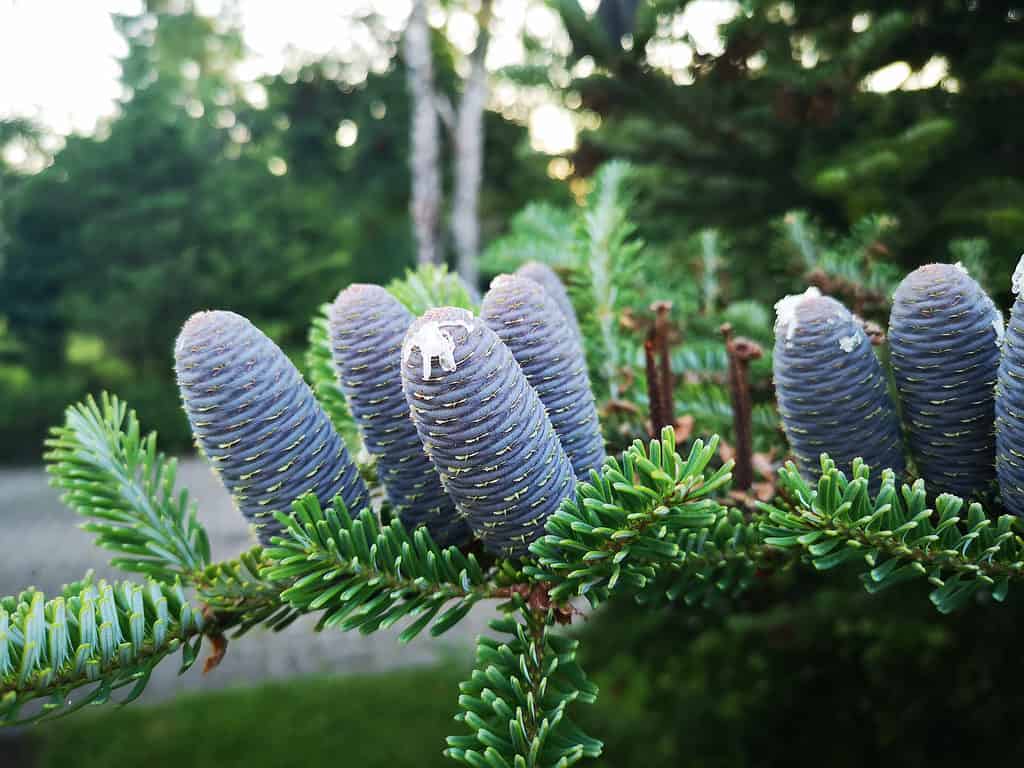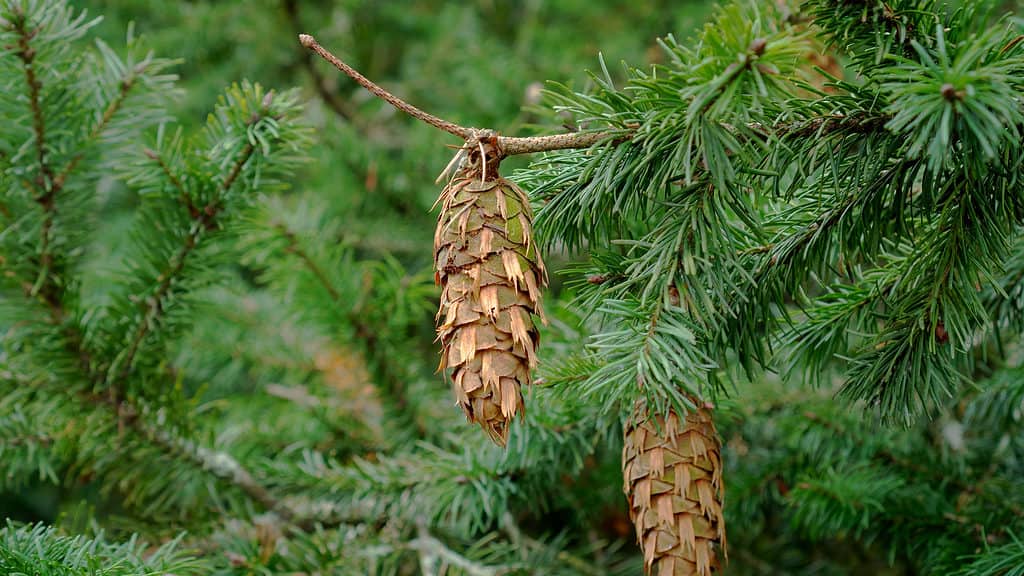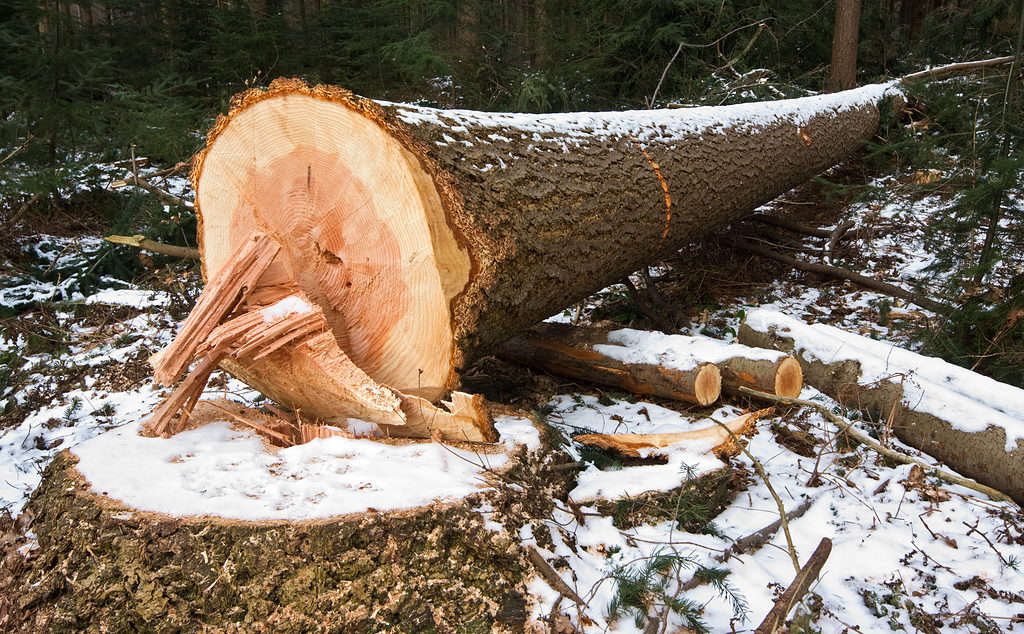Douglas fir and balsam fir trees are two popular Christmas tree options. Despite the similarities in appearance and name, these two coniferous legends aren’t closely related.
Let’s explore the key differences between the Douglas fir and balsam fir, so you can identify them and choose which one is right for you.
Comparing Douglas Fir vs. Balsam Fir
| Douglas Fir | Balsam Fir | |
|---|---|---|
| Classification | Pseudotsuga menziesii | Abies balsamea |
| Alternative Names | False hemlock, Douglas spruce, Columbian pine, Oregon pine | Canadian balsam, Eastern fir, bracted balsam |
| Origin | North America | North America |
| Description | Coniferous evergreen growing up to 80 feet tall and 20 feet wide when cultivated, but up to 300 feet tall in its natural setting. Silvery green needles are aromatic when disturbed. Cones measure 4-5 inches long with a golden brown hue. | Coniferous evergreen growing up to 60 feet tall and 25 feet wide when cultivated, but up to 90 feet in its natural setting. Blue-green needles with silvery underbellies are aromatic when disturbed. Cones measure 3-4 inches long, starting as a deep purple tone and maturing to brown. |
| Uses | High-quality timber trees for construction, furniture building, and shipbuilding. Sometimes used as a Christmas tree. | The most popular type of Christmas tree. Also used for pulp wood. The resin is used for candle making and as an adhesive ingredient. |
| Growth Tips | Grows in USDA Zones 4-6 in full sun and well-draining soil. Thrives in cool, coastal environments and struggles in hot, humid areas. | Grows in USDA Zones 1-6, though cultivars in the United States do better in Zones 3-6. Thrives in partial to full sun in well-draining soil. Thrives in cool, natural areas and struggles in hot climates or areas with significant pollution. |
| Interesting Features | Douglas fir trees are recognizable by their one-of-a-kind cone bracts (segments or scales) that end in a forked tip. | Balsam fir cones grow upward, starting in a unique purple shade that lightens to brown with maturation. |
Douglas Fir vs. Balsam Fir: Key Differences
Despite the common names, the Douglas fir and balsam fir aren’t closely related. The Douglas fir is a member of the genus Pseudotsuga, and the balsam fir is a member of the genus Abies.
The Douglas fir grows a lot taller than the balsam fir in the wild, with some cultivars reaching 250 to 300 feet tall in their natural environment. Balsam firs grow 80-90 feet in their natural environment but are more commonly found at 50-60 feet tall.
Douglas firs are a strong timberwood tree, often used in shipbuilding, construction, and furniture-making. Balsam firs aren’t as durable and are typically used in pulpwood and light wood-based projects, like making panels and boxes. Balsam fir resin is also used for aromatherapy, candlemaking, and as an ingredient in adhesive products.
Both the Douglas fir and balsam fir can be used as Christmas trees, but balsam is preferred. The Douglas fir tends to be quite dense, making tree decorating challenging. Balsam fir trees are also more cold-hardy and common across Canada.
The Douglas fir has unique cones, recognizable by the forked tips on each individual cone scale (bract). The balsam fir cones are also notable for their erect cones, which grow upward rather than dangling from the branch.

Balsam fir cones grow upward, starting in a unique purple shade that lightens to brown with maturation.
©Kolde IT/Shutterstock.com
Douglas Fir vs. Balsam Fir: Classification
The Douglas fir is classified as Pseudotsuga menziesii. Pseudotsuga means “false Hemlock,” which alludes to the Douglas fir’s similarity to the hemlock tree. The word menziesii isn’t a translation but rather a name given to honor botanist Archibald Menzies who discovered the species. The common name, “Douglas,” pays homage to David Douglas, another botanist who contributed to the discovery.
The Pseudotsuga genus is home to several fir trees, often generalized as Douglas firs. This creates confusion with the other species in this genus. However, the Pseudotsuga menziesii is the “true” Douglas fir. Despite similarities in appearance, members of the “false hemlock” genus produce resin, while hemlocks do not. The Douglas fir is often mislabeled as spruce or pine.
The balsam fir is classified as Abies balsamea. It’s a direct translation: Abies means “fir,” and balsamea translates to “balsam.” There are 50-60 other fir trees in the Abies genus and several cultivars.
Both the Douglas fir and balsam fir are in the Pinaceae family, with pines, spruces, hemlocks, and other coniferous trees and shrubs.

Douglas fir trees (
Pseudotsuga menziesii) are recognizable by their one-of-a-kind cone bracts (scales) that end in a forked tip.
©iStock.com/PAVEL IARUNICHEV
Douglas Fir vs. Balsam Fir: Origin
The Douglas fir and balsam fir are both native to North America, spanning up from the mid-United States and into Canada.
The Douglas fir grows heavily along the west coast, ranging from California up to British Columbia. Douglas firs prefer the cool, coastal region as they struggle with extreme cold or hot temperatures.
The balsam fir is prevalent along the North East United States and ranges from the East Coast of Canada into the central provinces. Many of these trees are naturalized in extreme winter settings, making them ideal for Christmas tree growth in Canada.

Balsam trees are a popular type of Christmas tree.
©Gus Garcia/Shutterstock.com
Douglas Fir vs. Balsam Fir: Description
The Douglas fir typically grows up to 80 feet tall and 20 feet wide when cultivated. However, naturally occurring Douglas firs in the Pacific Northwest grow 250 to 300 feet tall, making them one of the tallest trees in North America (next to the sequoias).
The Douglas fir has silvery green needles, which are aromatic when disturbed. The cones measure 4-5 inches long with a golden brown hue and have three-pronged bracts, which are unlike any other tree. The bark is grey to brown with deep crevices and distinct segments. This is a coniferous evergreen that survives year-round.
The balsam fir typically grows up to 60 feet tall and 25 feet wide (at the base) when cultivated and 80-90 feet tall in a natural setting. It grows in a pyramidal shape with blue-green needles with a silvery underside, emitting a strong fragrance when disturbed.
Balsam fir tree cones measure 3-4 inches and grow upward, starting as a unique dark purple shade, which lightens to brown as it matures. The bark is smooth and gray, often mottled with darker gray resin blisters that look similar to raised scars. This is a coniferous evergreen that survives year-round.
Douglas Fir vs. Balsam Fir: Uses
The Douglas fir is a popular timber wood tree due to its strength and durability. It’s often used in shipbuilding, construction, and furniture-making.
The Douglas fir has a rich history. It was the preferred tree for longboat and canoe building during ancient times on the West Coast. While Douglas Firs don’t grow in Hawaii (aside from the few planted around David Douglas’s grave), the indigenous people would collect the trees that washed up on shore as a blessing.
The roof of the Tacoma Dome is also made from Douglas fir trees that blew down during Mount St. Helen’s eruption. As this tree is so popular on the West Coast, it’s the official Christmas tree of Oregon.
The balsam fir is Canada’s most popular Christmas tree option, with many Eastern states importing this species during the holidays. Balsam fir isn’t sturdy enough for construction but is often used for plywood, box making, and light wood crafts.
Balsam firs also have a rich history and were commonly used by the Cree people for natural salves and aromatherapeutic medicinal treatments. They were also used as flooring for traditional teepees. Now, balsam tree resin is often used as a natural aroma in essential oils and candles. The resin is used to make glue.

The Douglas fir is a popular timber wood tree due to its strength and durability, often used in shipbuilding, construction, and furniture-making.
©iStock.com/Matauw
Douglas Fir vs. Balsam Fir: Growth Tips
Douglas fir and balsam fir are often grown as ornamental trees in parks and green spaces. However, they’re slow growers and not appropriate for urban areas due to their size. Take their growth patterns into consideration before planting near your house.
The Douglas fir grows in USDA Zones 4-6 in full sun and acidic, well-draining soil. Cover the base of your tree with mulch to trap moisture, and water regularly until established. Douglas fir will often split into two trunks as a seedling. Prune the smaller trunk to let the larger one become dominant. This prevents the risk of splitting and danger as the tree grows.
The balsam fir grows in USDA Zones 1-6, though cultivars in the United States do better in Zones 3-6. If you’re planting in Canada, be sure to choose a localized sapling. The balsam fir grows in partial to full sun in well-draining soil. Cover the base of your tree with mulch to trap moisture, and water regularly until established. Thrives in cool, natural areas and struggles in hot climates or areas with significant pollution.
The photo featured at the top of this post is ©
Sources
- Dictionary of Canadian Biography, Available here: http://www.biographi.ca/en/bio/menzies_archibald_7E.html
- Dictionary of Canadian Biography, Available here: http://www.biographi.ca/en/bio/douglas_david_6E.html
- Trees Pacific NW, Available here: https://www.treespnw.com/resources/what-is-a-bract-on-a-cone
- Maclean's, Available here: https://archive.macleans.ca/article/1979/3/5/a-man-a-tree-and-an-ocean-to-cross
- HistoryLink.org, Available here: https://www.historylink.org/file/5154
- Travel Oregon, Available here: https://traveloregon.com/things-to-do/find-your-perfect-christmas-tree-in-oregon/
- Cree Board of Health and Social Services of James Bay, Available here: https://www.creehealth.org/health-tips/traditional-medicine-balsam-fir
Thank you for reading! Have some feedback for us? Contact the AZ Animals editorial team.






